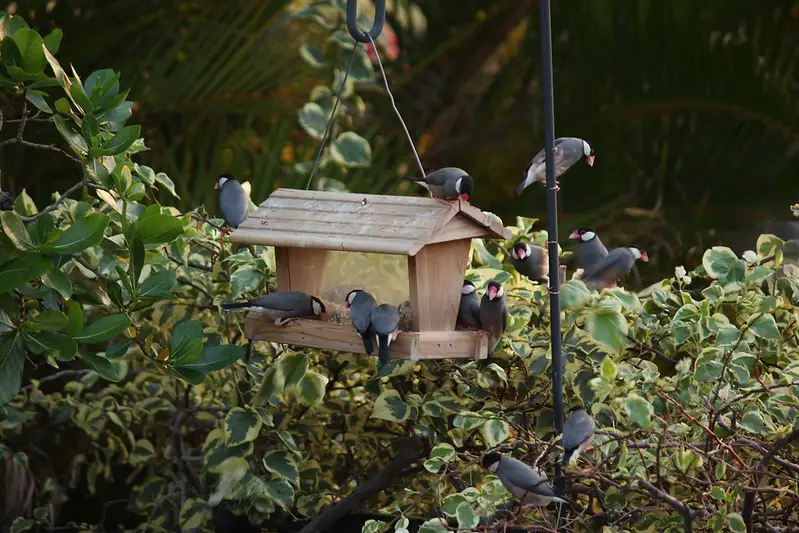Hawaii is a beautiful state in the western United States, located at the Pacific Ocean about 2,100 miles off the coast of the U.S.
It is also the only State outside of North America, the second-lowest state in terms of population, and the sole state consisting entirely of islands.
Hawaii is one of the most popular vacation spots in America not least because of its amazing animal life!
I am especially fascinated by the rich birdlife of Hawaii, and with more than 300 bird species Hawaii, many of which are not found on the mainland of North America, and 60 of which are not found anywhere else in the world, there is plenty to look at!
The top 13 birds at Hawaiin bird feeders
| Common name | Scientific name | Prevalence | |
| 1 | Java Sparrow | Lonchura oryzivora | 32% |
| 2 | Zebra Dove | Geopelia striata | 23% |
| 3 | Spotted Dove | Streptopelia chinensis | 17% |
| 4 | Red-whiskered Bulbul | Pycnonotus jocosus | 6% |
| 5 | Rose-ringed Parakeet | Psittacula krameri | 5% |
| 6 | Red-vented Bulbul | Pycnonotus cafer | 3% |
| 7 | Red-crested Cardinal | Paroaria coronata | 3% |
| 8 | Northern Cardinal | Cardinalis cardinalis | 3% |
| 9 | Red-billed Leiothrix | Leiothrix lutea | 2% |
| 10 | Common Myna | Acridotheres tristis | 1% |
| 11 | House Finch | Haemorhous mexicanus | 1% |
| 12 | House Sparrow | Passer domesticus | 1% |
| 13 | White-rumped Shama | Copsychus malabaricus | 1% |
As I have pointed out for many of the listed birds in their description below, the birds thriving in the Hawaiian nature where usually first described as native to Southeast Asia and will therefore resemble these exotic regions more than anywhere in North America.
Because the ecology and climate of Hawaii is so different from the mainland United States, the most common backyard birds of Honolulu will be quite different from those that would show up in a garden of Los Angeles, Chicago or New York.
- Photographs and identifies birds coming to your bird feeder!
- Notifies you via the app whenever a bird stops by!
- Excellent resolution and battery performance with the 6MP image sensor.
- Connect from anywhere with internet access (watch birds even when you are not at home!)
- Count the birds visiting your feeder and contribute to projects such as FeederWatch!
Many birds that, would otherwise only reside in forests or plains outside the cities, may be tempted by the easily accessible food of bird feeders in more urbanized areas.
Although it may disappoint you to hear that the most iconic birds of Hawaii such as the ‘I’iwi, the Nene, and the Hawaii Elepaio, are not easily attracted to bird feeders, fortunately, many other impressive bird species are!
As you will see in this post, few feeder birds of Hawaii are indeed unique to Hawaii, and many are the same as you could see elsewhere in the US. However, the mix of the cheeky Java Sparrow, exotic doves, parrots and the brightly colored Leiothrix and different cardinals will surely satisfy your birdwatching heart!
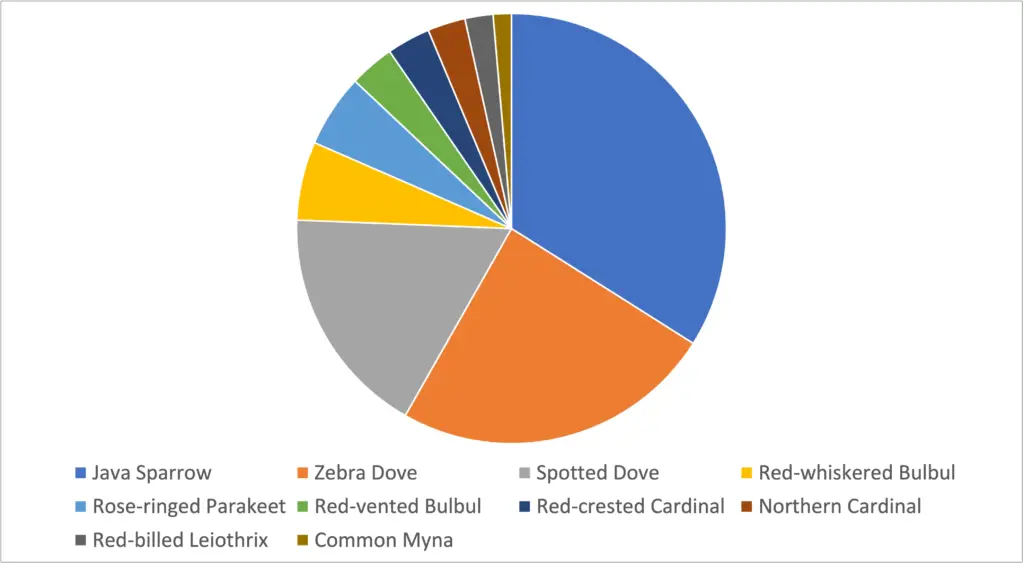
Contents
1. Java Sparrow (Lonchura oryzivora)
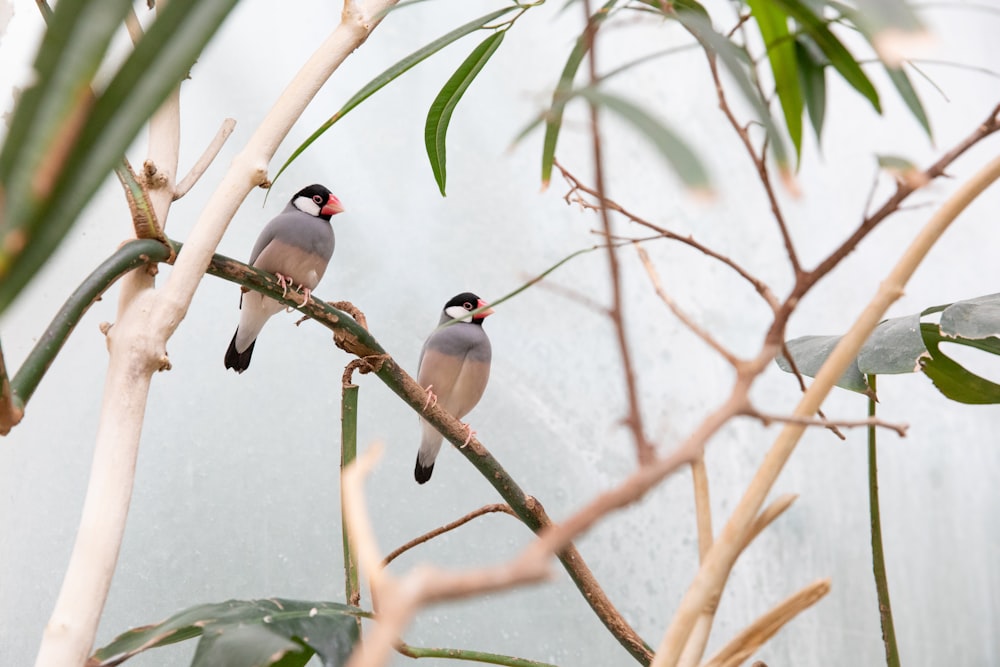
The Java Sparrow (sometimes referred to, perhaps more rightfully, as Java Finch) is a small colorful finch with a characteristic orange found widely across the world, mostly in Asia, Puerto Rico, Fiji, Mexico and Hawaii, but likely originates from Bali, Madura, and the Java islands (from which it got its name!) in Indonesia. However, the bird is now more widespread in other parts of the world compared to its original island habitat in Indonesia.
The Java Sparrow is also sometimes called paddy bird or rice bird and it is known for invading crops in large numbers. Therefore, the Java Sparrow is restricted in many parts of the US where agriculture is important due to its potentially devastating effects.
From the feederWatch data, we can calculate that the average flock size of Java Sparrows at bird feeders in Hawaii is 15 birds. It is furthermore seen at 85% of all participating bird feeders, which makes the Java Sparrow the most abundant bird at bird feeders in Hawaii.
How to determine the gender of a Java Sparrow – see video below!
Java Sparrow summary:
Family: Estrildidae
Origin: Southeast Asia – Indonesian Islands.
Diet: Grains and seeds.
Endangered: In some areas yes. It is on the IUCN Red list of threatened species.
% of Hawaiian feeders visited: 85%
Average flock size: 15
% of total birds at Hawaiian feeders: 32%
2. Zebra Dove (Geopelia striata)
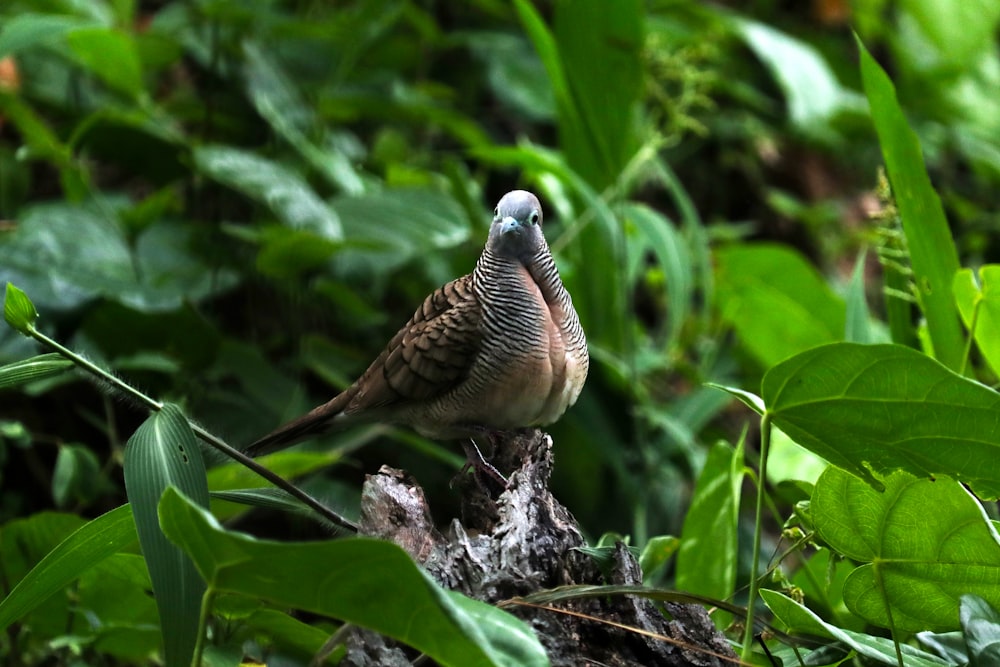
The Zebra Dove is a grey to brown colored bird that originates from the islands of Southeast Asia. It is named after its characteristic striped pattern around the neck (not to be confused with the spots of the spotted dove). The voice of the Zebra Dove is said to be calming and soft compared to other doves, and this may be the reason that they are popular as pets in some regions.
Where does the Zebra Dove come from?
The Zebra Dove is now found throughout the world but mostly in subtropical regions and mostly on Islands. Some of the locations where it may be found, apart from the Hawaii islands, are Indonesia (Sumatra and Java), Borneo, Thailand, Tahiti, Mauritius and the Philippines.
According to the data from FeederWatch, it has been observed 249 times in Hawaii in 2021. It has been observed at all participating bird feeders and it comes in a flock size averaging 9 birds per feeder.
Zebra Dove summary:
Family: Columbidae
Origin: Southeast Asia – Indonesia, Thailand, Malaysia.
Diet: Weeds and grass seeds, insects.
Endangered: No.
% of Hawaiian feeders visited: 100%
Average flock size: 9
% of total birds at Hawaiian feeders: 23%
3. Spotted Dove (Streptopelia chinensis)
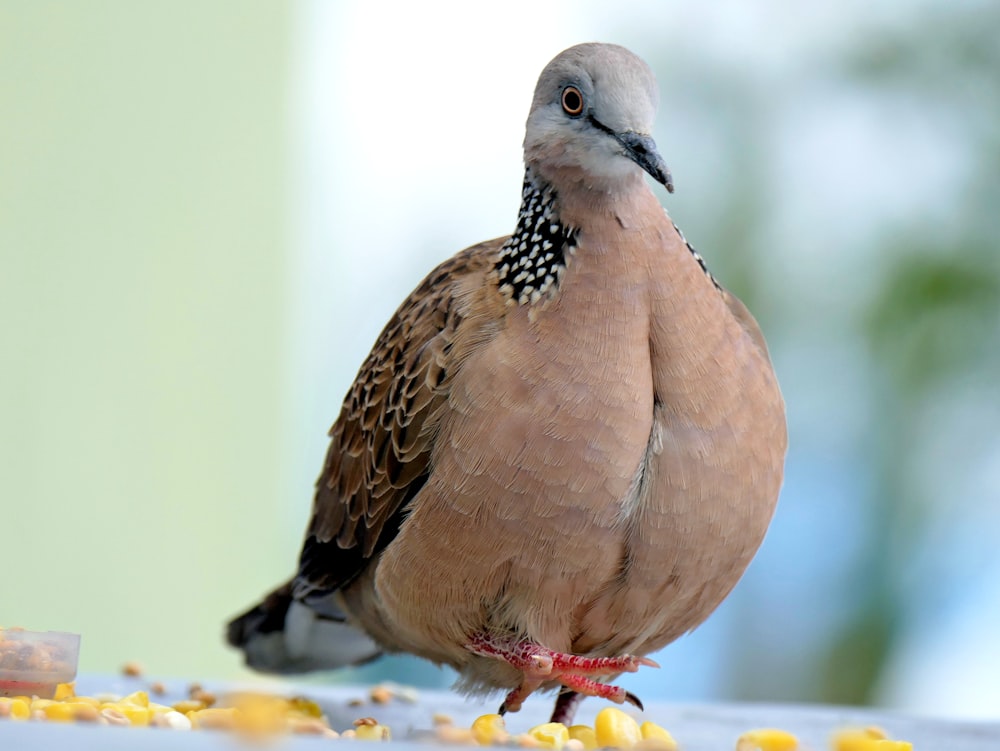
The Spotted Dove does resemble the Zebra Dove in many ways and is also known as: lace necked dove, pearl necked dove, spotted turtle dove and mountain dove.
Its feathers have a grey, brown base with a rosy tint and the characteristic back of the neck is black with white spots.
The Spotted Dove is found throughout Asia and Oceania as well as some parts of the Western United States.
It is somewhat approachable and may appear tame in urban areas.
According to the FeederWatch, it has been observed 179 times in Hawaiian bird feeders in 2021. It has been observed at almost all participating bird feeders (96%) and it comes in a flock size around 7 birds per feeder.
For a recording of the Spotted Dove in action, see the video below:
Spotted Dove summary:
Family: Columbidae
Origin: Asia and Oceania.
Diet: Weeds and grass seeds, insects.
Endangered: No.
% of Hawaiian feeders visited: 96%
Average flock size: 7
% of total birds at Hawaiian feeders: 16.5%
4. Red-whiskered Bulbul (Pycnonotus jocosus)
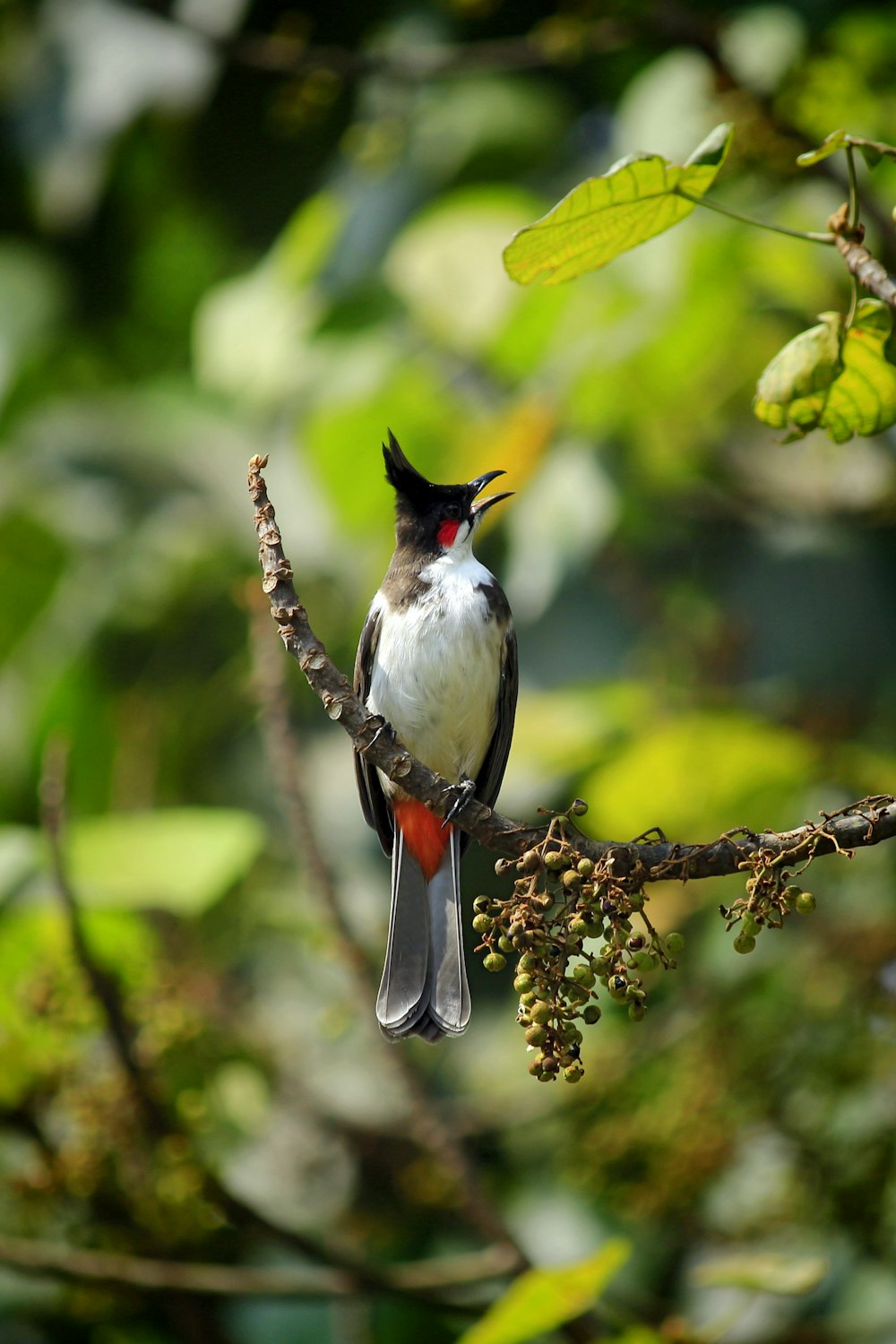
The Red-whiskered Bulbul, also known as the Crested Bulbul, is a member of the bulbul family (Pycnonotidae) of medium sized songbirds that also includes the Brownbul, the Greenbul and the Red-vented Bulbul (see further down the list!).
It is easily recognizable with its approximately 20cm long body, dark brown back, white underparts, tall crest, and red spot on the cheeks.
Although it is native to the tropical parts of Asia, it has now spread across the world to not only Hawaii, but also other states of the US such as California (Los Angeles) and Florida (south of Miami).
In many exotic places, including Hawaii and Mauritius, it is seen as an invasive species threatening the native unique plant life and helps the spread of invasive plants.
The Red-whiskered Bulbul is considered a shy species that is often found in smaller groups, and when we investigate the FeederWatch data, we can see that the Hawaiian population is uniquely present on the Oahu Island and that it has been observed at two-thirds of the feeders.
It is seen in groups of 3 on average and makes up 5.6% of the total birds observed.
Red-whiskered Bulbul summary:
Family: Pycnonotidae
Origin: Tropical Asia.
Diet: Fruits, insects.
Endangered: No.
% of Hawaiian feeders visited: 66%
Average flock size: 3
% of total birds at Hawaiian feeders: 5.6%
5. Rose-ringed Parakeet (Psittacula krameria)

This medium-sized parrot is the most widespread of all birds in the parrot family, because it thrives in countries far out of its native tropical range.
The Rose-ringed Parakeet is also called the ring-necked parakeet and it is found mostly in tropical Africa and Asia, but can be found in large parts of Asia, the Middle east as well as some parts of the US and Europe.
Rose-ringed Parakeets like to live near humans because the gardens, bird feeders and parks provide them with easy nourishment.
Its sharp hooked bill can rip through most fruits and even nutshells. The most numerous urban populations live in the cities of Pakistan and Northern India.
The Rose-ringed Parakeet lives mostly in large flocks, except for mating in late December. Being large numbers help them fight away predators and they can quickly empty fruit plantations and grains in farmyards together.
Although it is a playful and social bird that seems to prefer company of many of its kind, it was mostly observed in bands of around 3 birds at each bird feeder in Hawaii. It was observed at 66% of all feeders and was the fifth most abundant bird in the dataset for 2021.
Watch the Rose-ringed Parakeet feed at a Hawaiian bird feeder here:
Rose-ringed Parakeet summary:
Family: Psittaculidae (Old World parrots)
Origin: Tropical Asia and Africa.
Diet: Fruits, seeds, nuts.
Endangered: No.
% of Hawaiian feeders visited: 66%
Average flock size: 3
% of total birds at Hawaiian feeders: 5.2%
6. Red-vented Bulbul (Pycnonotus cafer)
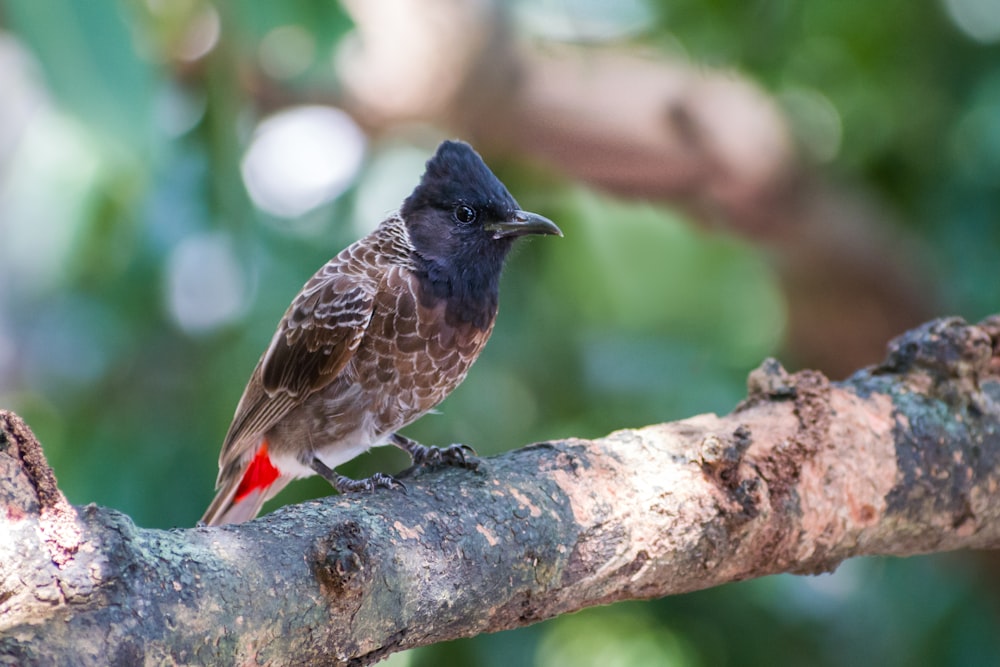
The Red-vented Bulbul is related to the Red-whiskered Bulbul both belonging to the same genus of Pycnonotus within the family of songbirds. Its scaly brown body pattern, its black hooded look and the red spot under its tail makes it easy to distinguish from the Red-whiskered Bulbul.
It is native to the south Asian continent, but has been introduced to the islands of Hawaii, Samoa, Fiji and Tonga where it mostly eats fruits, flower buds and insects. It is considered an invasive species in these countries as it ravages crops and gardens, where orchids are especially prone to destruction. It also aids the spread of invasive plants that further disrupts the native ecosystems.
FeederWatch data suggests that it is the 6th most common bird at bird feeders in Hawaii, and is most often seen in pairs. It has been observed at 74% of feeders making up 3.2% of total observations.
Red-vented Bulbul summary:
Family: Pycnonotidae
Origin: Tropical, south Asia.
Diet: Fruits, insects, flower buds.
Endangered: No.
% of Hawaiian feeders visited: 74%
Average flock size: 2
% of total birds at Hawaiian feeders: 3.2%
7. Red-crested Cardinal (Paroaria coronate)
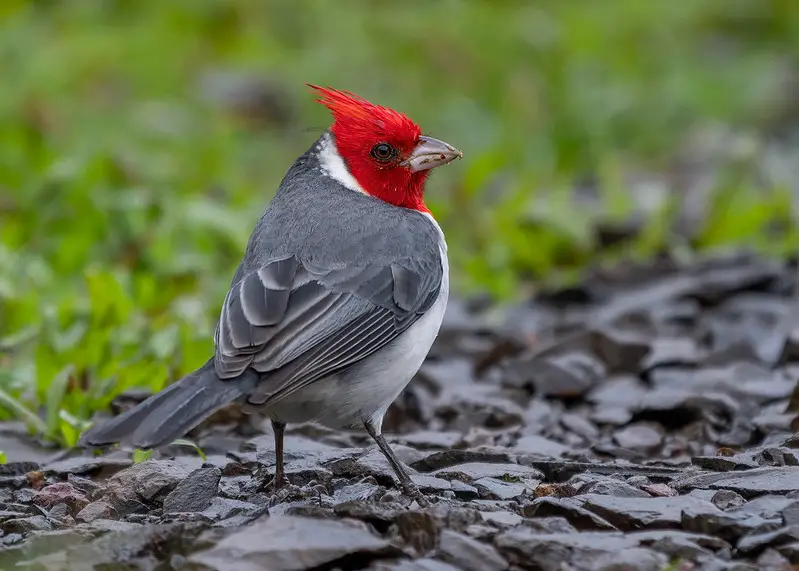
The Red-crested Cardinal is a red headed bird of Hawaii that is very similar to the red-cowled cardinal. Both the Red-crested Cardinal and the red-cowled cardinal are smaller relatives of the Northern cardinal with only its head in crest being the characteristic bright red color.
The Red-crested Cardinal inhabits more exotic regions than its Northern cousin, which makes their co-existence a rare occasion. Its fondness of the tropics may explain why it is slightly more common in Hawaii compared to the otherwise (in the US) more common Northan cardinal.
The Red-crested Cardinal inhabits a large part of South American savannah in Paraguy, Uruguay, Brazil, Bolivia, and Argentina. It likes to sing from bushes and treetops close to rivers and lakes.
It is not endangered, but loss of some of its main habitats and popular use as pets may be problematic in the future.
From the bird feeder frequency data, we can see that it visited a staggering 96.6% of all participating bird feeders in Hawaii in 2020 – 2021. It usually shows up alone and constitutes only 3.1% of the total birds observed.
Red-crested Cardinal summary:
Family: Thraupidae
Origin: South America.
Diet: Fruits, seeds, berries, insects.
Endangered: No, but loss of habitat.
% of Hawaiian feeders visited: 96.6%
Average flock size: 1
% of total birds at Hawaiian feeders: 3.1%
8. Northern Cardinal (Cardinalis cardinalis)
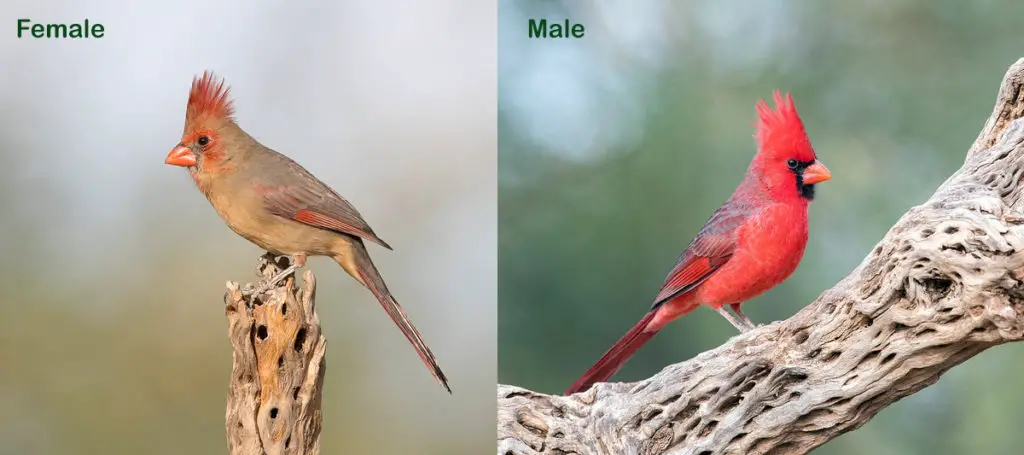
The Northern Cardinal is a common backyard bird seen throughout the United States, where it may also go under the nicknames of red cardinal, common cardinal, redbird or simply cardinal. Its many names exemplify its representation of the wider cardinal family, Cardinalidae, which includes several other common birds such as the Dickcissel, some grosbeaks, and the buntings.
It is native to the Southeastern United States, where it is the official state bird of several states: West Virginia, Indiana, Virginia, Ohio, Illinois, Kentucky and North Carolina. Furthermore, several institutions, including sports teams such as the St. Louis Cardinals and Arizona Cardinals use it as their mascot.
All cardinalids are highly vocal, and many are strongly colored, making them easy to spot at the bird feeder. Especially the brightly blue Indigo Bunting and the multicolored Painted Bunting are amazing examples of this colorful family.
Whereas some cardinals are brightly colored entirely, the Pyrrhuloxia, which has a parrot-like bill and is considered the Southwest’s equivalent of the Northern Cardinal, is gray with crimson red patches throughout its body.
The male Northern Cardinal is easy to recognize as it is the only bright red bird seen all year round in the Northern parts of the US. The female is predominantly brown and less brightly colored which may lead to confusion with other Cardinalids, for example its Pyrrhuloxia, Summer Tanager, or Hepatic Tanager cousins. These cardinals, however, are more widespread in the southwestern states and northern Mexico where the Northern Cardinal is less common.
It prefers relatively moist habitats, such as deciduous woodlands, scrublands, desert washes, and backyards. Their breeding season is March-August where the Northern Cardinal comes across as exceptionally noisy, boasting a loud metallic voice with which it sounds the characteristic “tik-tik” call or a softer slurred whistle. The male is aggressive and repels any intruder. He is so aggressive that he will occasionally confront his own reflection in windows and various shiny surfaces.
The nest of the Northern Cardinal is somewhat flimsy with thin barks, grasses and leaves. The female lays 2-4 turquoise brown-spotted eggs per nesting season, but they do not usually use the nest again.
The Northern Cardinal diet consists mainly of seeds and fruits whereas the young receive mostly insects from their parents. The Northern Cardinal feeds on many different seeds at bird feeders, but feeders with corn, oats, safflower and especially sunflower seeds seem to be popular with the Northern Cardinal.
The preferred foods of Northern Cardinals include:
- crickets
- buckwheat
- flies
- moths
- spiders
- centipedes
- cicadas
- beetles
- grass
- butterflies
- seeds
- sumac
- mulberries
- hackberry
- blackberry
- wild grape
The Northern Cardinal in Hawaii
The Northern Cardinal has recently been introduced into Hawaii where it is a frequent visitor of bird feeders, but is also a concern for the native ecology. The first introduction to Hawaii took place in 1929 when an encaged pair escaped from Honolulu. Since then, it spread rapidly and became endemic around the 1940’s and was found throughout Oahu by the 1970s.
Whereas the general population of the United States is stable, the population of Hawaii is in slow decline and is now almost absent from some Hawaiian islands such as Kauai.
From the FeederWatch participants in Hawaii, we can see that the Northern Cardinal has been observed at 74% of the bird feeders and accounts for 2.7% of total bird observations.
It usually comes to the feeder alone, and has mostly been observed on the Oahu Island. At the national level in the US, the trend is stable over time and the majority of observations of the Northern Cardinal have been made in the Eastern parts of the country.
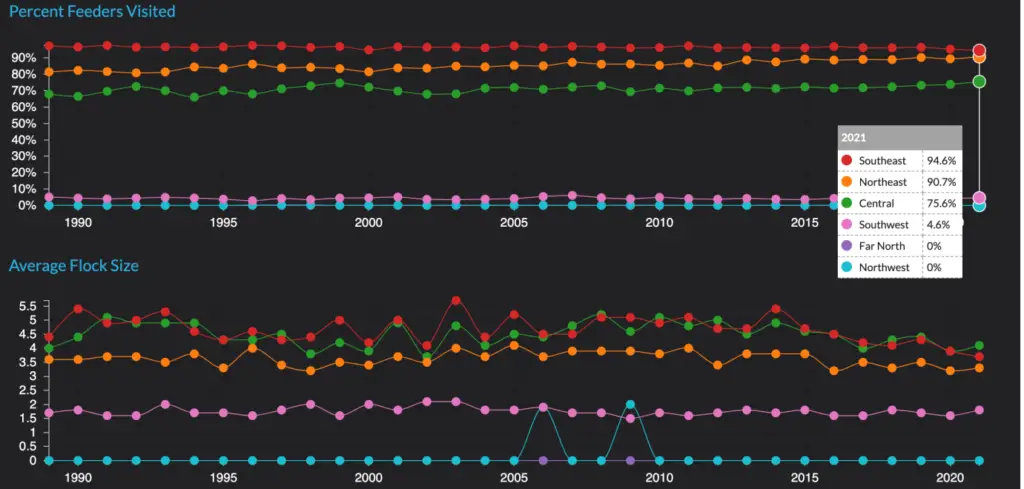
Northern Cardinal summary:
Family: Cardinalids
Origin: Eastern US.
Diet: Seeds, berries, insects.
Endangered: No.
% of Hawaiian feeders visited: 74.1%
Average flock size: 1
% of total birds at Hawaiian feeders: 2.7%
9. Red-billed Leiothrix (Leiothrix lutea)
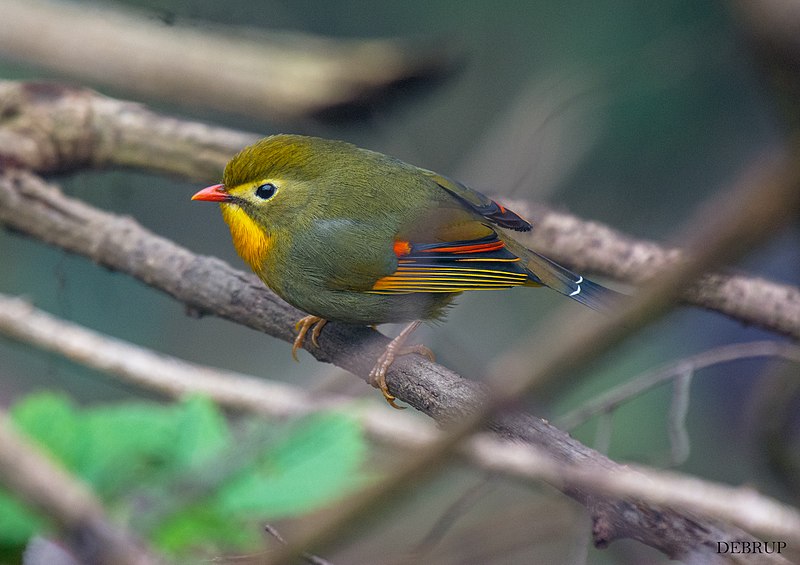
The Red-billed leiothrix (also known as Pekin robin, Pekin nightingale, Japanese hill robin and Japanese nightingale) is a brightly colored bird of the Leiothrichidae family. Its feathers are generally olive green with a yellow throat with deep blue, orange and white features throughout.
It is native to Asia, and is particularly common in China, India, Nepal, Burma, Tibet and Bhutan where it is widespread in jungle-covered highlands but prefers bushes and pine forests where it forages and nests in the lower dense vegetation. It feeds mostly on fruits and insects and for example, papaya fruits can be used to attract them to feeders.
The red-billed leiothrix is not native to Hawaii, but was, due to its colors and song it is popular as a pet, and was introduced to the Hawaiian Islands in 1918 and further introductions in the following years. It quickly spread throughout the Hawaiian Islands and it was one of the most common feeder birds of Hawaii in the 1950s, but the population declined drastically throughout the 1960s and started to show up again in the 1980s.
From the bird feeder frequency data, we can see that it visited a staggering 29% of all participating bird feeders in Hawaii in 2020 – 2021. It usually shows up in packs of 3 and constitutes only 2% of the total feeder birds observed in Hawaii.
Red-billed leiothrix summary:
Family: Leiothrichidae
Origin: Asia, highland.
Diet: Fruits, insects.
Endangered: No.
% of Hawaiian feeders visited: 29%
Average flock size: 3
% of total birds at Hawaiian feeders: 2%
10. Common Myna (Acridotheres tristis)
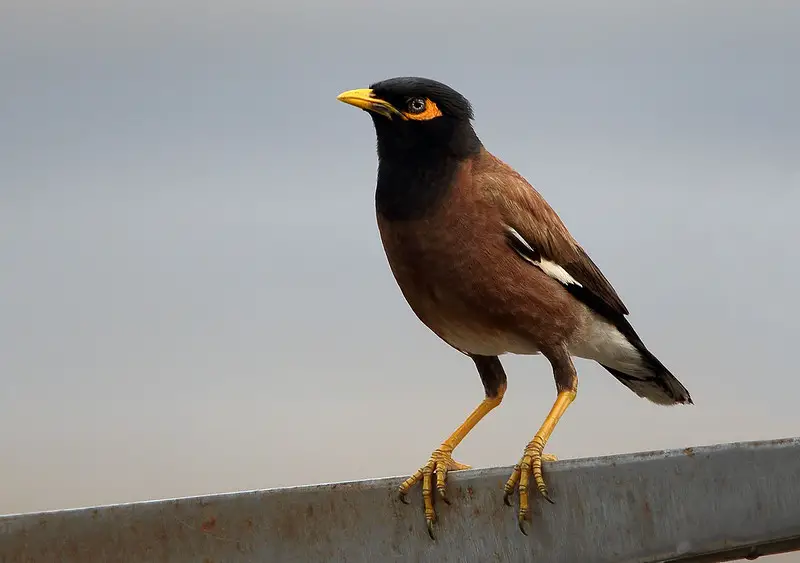
The Common Myna, also sometimes called the Indian Myna; alternatively spelled Mynah. It belongs to the Sturnidae family of Mynas and starlings and is dark in color, mostly brown with yellow bill, legs and yellow areas around the eyes. Mynas are intelligent birds and along with its cousin, the tropical Hill Myna bird, Mynas are often kept as pets thanks to their ability to imitate human speech.
Whereas the Common Myna is native to and common throughout Asia and originally native to Iran, India, Kazakhstan, Malaysia and China, it is now widely introduced to Africa, Oceania, Mid- and South America.
In areas where common mynas have been introduced, they often affect native birds and seabird species by feeding on their eggs and young, and it is considered a pest in North America, the Middle East, South Africa, Australia, New Zealand and Pacific islands. For example, it poses a serious threat to the Australian blueberry plants where it also competes with the native parrot species.
This is not only due to the fact that they disrupt the local ecology, but also because the Common Mynas may be responsible for the spread of certain parasites such as avian malaria and Ornithonyssus bursia; a mite that causes dermatitis in humans.
Altough it is considered an invasive species in many areas of the world, including Hawaii, the common myna has helped control the populations of sniffworms (Spodoptera mauritia) on the Hawaiian Islands. In Florida, they compete with purple martyrs for nesting spots, but that’s not so problematic in Hawaii.
In urban areas Common Mynas feed mainly on soil insects, tropical fruits, such as grapes, plums, and berries discarded by humans, but are largely omnivorous.
The FeederWatch data suggests that the Common Myna is a rare guest at bird feeders. It is seen at 22% of bird feeders participating in Hawaii, and is has not yet been observed at bird feeders in any other American state. It is most often seen in pairs, but only makes up 1.3% of total bird counts in Hawaii.
Common Myna summary:
Family: Sturnidae
Origin: Asia.
Diet: Fruits, insects, omnivorous.
Endangered: No.
% of Hawaiian feeders visited: 22%
Average flock size: 2
% of total birds at Hawaiian feeders: 1.3%
11. House Finch (Haemorhous mexicanus)

The House Finch is a medium sized finch of the Finch (Fringillidae) family. It is native to the west coast of the USA and parts of Mexico but was brought to the East coast by petshop owners selling them as pets in New York (Long Island) in the 1940s. Although it was not legal to import and sell non-native birds, their quickly gained popularity as pets lead to the spread of the House Finch throughout the remaining states of North and East America.
From the 1960s the House Finch populations expanded from the Northeast towards the west coast to merge with its indigenous population by year 2000. However, mainly due to the House Finch’s unusual susceptibility to parasitic diseases, its numbers declined slightly in the 1990s but have since rebounded to record highs.
Identification and confusions
The House Finch is a common feeder bird but may be confused with the Purple Finch or the Cassin’s Finch as especially the females are very similar looking. However, there are some subtle but important differences that can help you to distinguish these finches from each other.
Weighing from 16g to 25g the House Finches tend to be slimmer than Purple Finches (20-30g) as well as the Cassin’s Finches (25-35g) and the latter two species have less pronounced markings and longer tails.
The colouring of the sister species is more diffuse and covers the head and goes down the back all the way to the tails, whereas the House Finch mostly have markings on the neck and a spot just above its tail.
The House Finch also have a red colour similar to that of the Purple Finch and the Cassin’s Finch, but the latter two have a darker purple or burgundy colour rather than the brighter strawberry red of the House Finch.
Another important fact that will make it easier for you to pinpoint the House Finch is that the Cassin’s Finch is only present in the south-western parts of the US and less associated with gardens and urban areas. The Cassin’s Finch is generally rare at bird feeders and only occurs in the west, so if you live in the east or central parts of the US it is much more likely that the red plumaged Finch at your feeder is a House Finch.
Mating and nesting of House Finches
During the nesting season from March till August, the female quickly builds a small nest from weeds, grasses and thin branches. It builds the nest in a matter of days and may place it in trees, hanging vegetation or man-made cavities.
The courtship of the House Finch is interesting in that it is sometimes selected based on the type of food it presents to its chosen female on their first date. This ritual may have come about due to the role of the male in feeding the female during the entire egg incubation.
What does the House Finch eat and how to attract it?
House finches eat grains, seeds, berries, flower buds and are avid consumers of weeds and smaller insects such as aphids. House Finches are one of the few bird species that prefers to feed their nestlings seeds and other plant material instead of the more protein rich insects. The nestlings prefer dandelion seeds so make sure to keep a few dandelions left in your garden if you want to attract the House Finch.
In Hawaii, the House Finch was introduced in the late 19th century where it quickly became known as the “Papaya bird”. Due to its large intake of papaya instead of the usual seeds and flower buds it would eat elsewhere, the Hawaiian House Finch often had a more yellowish tone compared to the mainland birds.
House Finches are common and very active at bird feeders, and you may use the following seeds to attract the House Finch to your bird feeder:
- Black oil sunflower seeds
- mustard seeds
- millet
- milo
- Cherries
- Apples
- Apricots
You may consider a tube feeder, a hopper feeder, or a Nyjer Feeder to attract the House Finch, however, it is also seen at nectar feeders, where it competes with humming birds for the sweat sap.
It does like to crack open the sunflower seeds and throw the shell on the ground, so make sure to allow for the empty shells to be tossed of easily.
So make sure to consider the location of your feeder as shells will collect underneath.
If you really want to make House Finches happy in your garden, you also need a way for them to drink and shower. Especially if the weather is warm, a House Finch may need to drink up to its own body weight in water each day!
A bird bath or a shallow pond could work for that purpose.
If, on the contrary, you do not want the House Finch at your feeder, you should make sure to have only nuts, suet, or animal-based feeder material such as mealworms.
You should keep dandelions out of your garden and not have any open water around for them to drink or shower.

House Finch summary:
Family: Fringillidae (True finches)
Origin: Southwestern US, and Mexico.
Diet: Weeds, grains, seeds, fruits, insects.
Endangered: No.
% of Hawaiian feeders visited: 25.9%
Average flock size: 2
% of total birds at Hawaiian feeders: 1.3%
12. House Sparrow (Passer domesticus)

I have never been in a country, from Northern Sweden to New Zealand, without seeing the House Sparrow happily hopping around. The House Sparrow and its relatives in the Passar genus are perhaps the most common birds in the world.
The omnipresence and familiarity of many households with the bird, is reflected in the first part of its common name “house” or the last part of the Latin name “domesticus” – literally meaning “near the house”.
The House Sparrow is highly adapted to the presence of humans and thrive in urban areas where they are very common guest of backyard bird feeders.
The House Sparrow is believed to originate from the Middle East from where it spread to Asia, North Africa and Europe following the human appreciation of agriculture.
Due to widespread introductions, facilitated by human sea travel, the House Sparrow is now found pretty much everywhere where humans reside!
The vast populations and geographical spread of the House Sparrow means that several subspecies have evolved and slight differences in their appearance is seen throughout different regions of the world.
Being introduced to the US for the first time in the 1850s via a ship headed for Brooklyn in New York, they are now very common throughout urbanized parts of the country.
Although common near humans, the House Sparrow is far less present in the vast forests of the most northern parts where the temperatures are more extreme and bird feeders rare.
How and where to spot the House Sparrow
Being a sparrow, it is small in seize with a length of 15 to 17cm (5.91-6.7 inches) and a weight around 30g (1.06 oz). The males are usually larger than the females and differ in display a darker plumage.
The back feathers of the male House Sparrow are generally dark brown, and the males have dark gray to black patches on the throat and on the top of their head. The females and juvenile House Sparrows are light brown, with less pronounced patches on their head and no dark area under their bill.
Due to the varied plumage of the House Sparrow, and the many similar sparrows withing the Passeridae family, it may be confused with other true sparrow species such as the Harri’s Sparrow, the White-throated Sparrow, and especially the Eurasian Tree Sparrow.
The latter was introduced to North America along with the House Sparrow in the 19th century but is only vaguely present and is now restricted to Iowa, Missouri and Illinois.
The huge success of the House Sparrow can be attributed to their early association with human farmers, that have given them time to evolve and adapt to human settlements and urbanization. This fact is reflected in their high presence in cities compared to less populated areas such as forest, mountain ranges and deserts.
Whereas they largest numbers are found in densely populated cities, the House Sparrow tend to breed more efficiently in the province where more insects and nesting opportunities are available.
Any appropriately sized cavity will serve as a nesting site for the House Sparrow couple. The couple is usually monogamous and partner for life. The House Sparrow may build its own nest, but more often takes a nest previously used by other birds.
Because the House Sparrow may scare away or kill the original inhabitants of a nests it would like to overtake, it is considered a threat to other less abundant smaller birds.
Although the House Sparrow was originally introduced to the United States to control pests in agriculture, the House Sparrow was later sought eradicated because considered a pest itself – eating crops from wheat and fruit farms.
However, it later turned out that it is more of a benefit than a plague to most American agriculture.
What does the House Sparrow eat and how do I attract it?
The House Sparrow feed mostly on seeds, grains and smaller insects but are, like pigeons, somewhat omnivorous – living on whatever food leftovers they find laying around. During its breeding season, it prefers mostly protein rich meals such as caterpillars, beetles, and flies.
Although rarer, it is also seen feeding on larger animals such as snails, spiders, and lizards.
Because the House Sparrow has basically adapted to your backyard, it is not hard to attract it! It will come for just about any eatable seed that fits its bill but will also pick on larger fruits and especially berries.
It is not very shy and will jump onto tables and may even enter houses to look for leftover foodstuff.
The House Sparrow prefers seeds and therefore tube feeders are ideal for attracting it. It eats most commercial bird seed mixes, but you may look for these particularly favoured seeds for your feeder:
- millet seeds
- sunflower seeds
- milo seeds
- canary seeds
- flax seeds
- safflower seeds
- Wheat
- Cracked corn
How to prevent the House Sparrow from coming to my feeder?
Because the House Sparrow is easily attracted to bird feeders, many people deal with another problem: How to get rid of it!
The House Sparrow can be loud and tends to throw around seeds and scare away other more shy feeder birds. If you find the House Sparrow annoying to have at your bird feeder, you should avoid the seeds listed above and try adding more thistle seeds, whole peanuts, nectar, or suet to your bird feeder.
Alternatively, you can create a so-called “sparrow spooker” consisting of shiny tin foil bands hanging from a stick near the feeder, which supposedly will scare off sparrow while not bothering most other backyard birds.
Fun fact – how old did the oldest House Sparrow get?
The oldest know House Sparrow was reported in Denmark and reached almost 20 years of age! This is much longer than the average age of 3 years normally observed for this, and most sparrow species.
Fun fact – single sparrows help couples!
If a young House Sparrow does not find a mate, it may seek out established couples and help them with foraging and to keep the nest safe from predators. It is believed that this behaviour allows the single members of the sparrow population to gain attractiveness by gaining experience and demonstrating their abilities.
House Sparrows at bird feeders in Hawaii
Being ubiquitous, the House Sparrow also pays an occasional visit to Hawaiian bird feeders although it is somewhat rarer here compared to the rest of the US. From the FeederWatch data, we can calculate that the House Sparrow is observed at 11% of all participating feeders, and usually shows up in groups of 4 birds. It makes up only 1.1% of all birds visiting Hawaiian bird feeders

House Sparrow summary:
Family: Passeridae (Old world sparrows)
Origin: Middle East, but now worldwide.
Diet: Weeds, grains, seeds, insects.
Endangered: No.
% of Hawaiian feeders visited: 11%
Average flock size: 4
% of total birds at Hawaiian feeders: 1.1%
13. White-rumped Shama (Copsychus malabaricus)

The White-rumped Shama is a small bird of the Muscicapidae family. They show different shades of brown, chestnut, grey, white and black in their plumage. Some species of Muscicapidae have red spots, and some have more blue plumage e.g. the Tickell’s blue flycatcher.
The White-rumped Shama originates from the Indian continent and Southeast Asia and as many members of the Muscicapidae the White-rumped Shama occurs in a variety of habitats, including tundra, grassland, swamp forests, backyards and tropical forests. However, their popularity as cage birds has led to the establishment of many escaped birds.
In Hawaii, the White-rumped Shama is the most abundant species in forests, ridges and valleys of Koolaus where it nests in the bushy vegetation or low trees of the lowland deciduous forests.
Although shy, they are territorial and share the territory with each other. They eat a varied diet of insects, worms, ants, caterpillars and locusts. They collect their prey on the ground or in the bushes with short jerky runs.
The voice of this species is rich and sonorous, making it a popular caged bird in South Asia, a tradition that continues in the Southeast parts of Asia. The species has been exploited due to its popularity as pets, which has lead to its near extinction in some countries and introduction as an invasive species in others.
The FeederWatch data suggests that the White-rumped Shama is a rare at bird feeders. While it has been seen at 40% of bird feeders participating in Hawaii, and is has not yet been observed at bird feeders in any other states. Because it is mostly seen alone, it only makes up 1% of total bird counts at feeders in Hawaii.
White-rumped Shama summary:
Family: Muscicapidae
Origin: Southeast Asia, India.
Diet: Fruits, insects, omnivorous.
Endangered: No.
% of Hawaiian feeders visited: 40%
Average flock size: 1
% of total birds at Hawaiian feeders: 1%
Backyard birds in other states
Are you interested in how the backyard birds in your state compare to other states?
Then check out my other blog posts below:
- Backyard birds of Alabama
- Backyard birds of Colorado
- Backyard birds of Delaware
- Backyard birds of Georgia
- Backyard birds of Hawaii
- Backyard birds of Illinois
- Backyard birds of Iowa
- Backyard birds of Kentucky
- Backyard birds of Louisiana
- Backyard birds of Maryland
- Backyard birds of Massachusetts
- Backyard birds of Missouri
- Backyard birds of Nebraska
- Backyard birds of New York
- Backyard birds of North Carolina
- Backyard birds of Oklahoma
- Backyard birds of Rhode Island
- Backyard birds of South Carolina
- Backyard birds of Tennessee
- Backyard birds of Texas
- Backyard birds of Virginia
- Backyard birds of West Virginia
- Backyard birds of Wisconsin
- Backyard birds of Wyoming
And in Canada:
- Backyard birds of Ontario
- Backyard birds of Prince Edward Island
- Backyard birds of Saskatchewan
- Backyard birds of Quebec
Not on the list? Check out the rest of my posts on backyard birds here!
Maybe you would like to know if the Blue Jay or Cardinal dominates in the bird feeder hierarchy or how birds such as seagulls sleep at night? Or why mourning doves poop so much and whether most birds can poop and fly at the same time!
A lightweight handy pair of binoculars is a must for your backyard bird watching! Check out my recent post on the best small lightweight binoculars for birdwatching etc.
My Favorite Backyard Birding Gear:
- Photographs and identifies birds coming to your bird feeder!
- Notifies you via the app whenever a bird stops by!
- Excellent resolution and battery performance with the 6MP image sensor.
- Connect from anywhere with internet access (watch birds even when you are not at home!)
- Count the birds visiting your feeder and contribute to projects such as FeederWatch!
If you are interested in posters and other wall arts etc. with drawings of all the backyard birds you have just read about, check out my portfolio over at Redbubble:
Acknowledgements
I want to thank the Cornell Lab of Ornithology at Cornell University and the Birds Canada organization as well as all the citizens who have been involved in the FeederWatch project for providing the data of this article. The data I have used to generate the prevalence numbers for this article is provided by the FeederWatch project. The FeederWatch project is an initiative by The Cornell Lab of Ornithology at Cornell University and the Birds Canada organization. The data is collected through an immense crowdsourced citizen science program, where citizens of the United States and Canada are invited to count birds at their bird feeders, identify the species, and report back to the scientists at Cornell University. The birds are counted from November to April and always in two consecutive days including only one area with a bird feeder, typically a piece of the backyard, observed from one vantage point. The two-day watch is then repeated throughout the season. The data is collected each year and is freely available to the public at https://feederwatch.org/.
References
American Museum of Natural History Birds of North America. DK; Revised edition (September 6, 2016). ISBN: 978-1465443991
National Geographic Backyard Guide to the Birds of North America, 2nd Edition. National Geographic; 2nd edition (October 15, 2019)
Birds of North America. National Audubon Society. (Knopf April 6, 2021). ISBN: 978-0525655671

